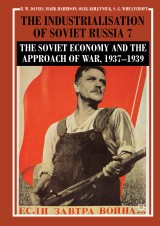Details

The Industrialisation of Soviet Russia Volume 7: The Soviet Economy and the Approach of War, 1937-1939
|
128,39 € |
|
| Verlag: | Palgrave Macmillan |
| Format: | |
| Veröffentl.: | 11.07.2018 |
| ISBN/EAN: | 9781137362384 |
| Sprache: | englisch |
Dieses eBook enthält ein Wasserzeichen.
Beschreibungen
<p></p><p>This book concludes <i>The Industrialisation of Soviet Russia</i>, an authoritative account of the Soviet Union’s industrial transformation between 1929 and 1939. The volume before this one covered the ‘good years’ (in economic terms) of 1934 to 1936. The present volume has a darker tone: beginning from the Great Terror, it ends with the Hitler-Stalin pact and the outbreak of World War II in Europe. During that time, Soviet society was repeatedly mobilised against internal and external enemies, and the economy provided one of the main arenas for the struggle. This was expressed in waves of repression, intensive rearmament, the increased regimentation of the workforce and the widespread use of forced labour.</p><br><p></p>
<p>1: The repressions of 1937-1938 and the Soviet economy.- 2: The political context of economic change: 1937 to the spring of 1939.- 3: The economic slowdown of 1937.- 4: 1937 in retrospect.- 5: The Soviet population and the censuses of 1937 and 1939.- 6: The partial recovery of the economy in 1938.- 7: Agriculture in 1938 and 1939.- 8: The drive for growth and the Eighteenth Party Congress, January-March .- 9: The economy in 1939: further moves to a war economy.- 10: The Soviet economy: the late 1930s in historical perspective.</p>
<p></p><p></p><p><b>R. W. Davies</b> is Emeritus Professor of Russian Economic Studies at the University of Birmingham, UK. </p>
<p><b>Mark Harrison</b> is Professor of Economics at the University of Warwick, UK, a Research Associate of Warwick’s ESRC Centre on Competitive Advantage in the Global Economy, and a Senior Research Fellow of the Centre for European, Russian, Eurasian Studies, University of Birmingham.</p>
<p><b>Oleg Khlevniuk</b> is Professor of History at the National Research University Higher School of Economics, Russian Federation, and Leading Research Fellow of the HSE International Centre for the History and Sociology of World War II and its Consequences. </p>
<p><b>Stephen G. Wheatcroft</b> is Professor of History at Deakin University, Australia, and a Professorial Fellow and Associate of the University of Melbourne.</p><br><p></p><p></p>
<p><b>Mark Harrison</b> is Professor of Economics at the University of Warwick, UK, a Research Associate of Warwick’s ESRC Centre on Competitive Advantage in the Global Economy, and a Senior Research Fellow of the Centre for European, Russian, Eurasian Studies, University of Birmingham.</p>
<p><b>Oleg Khlevniuk</b> is Professor of History at the National Research University Higher School of Economics, Russian Federation, and Leading Research Fellow of the HSE International Centre for the History and Sociology of World War II and its Consequences. </p>
<p><b>Stephen G. Wheatcroft</b> is Professor of History at Deakin University, Australia, and a Professorial Fellow and Associate of the University of Melbourne.</p><br><p></p><p></p>
<p></p><p>This book concludes <i>The Industrialisation of Soviet Russia</i>, an authoritative account of the Soviet Union’s industrial transformation between 1929 and 1939. The volume before this one covered the ‘good years’ (in economic terms) of 1934 to 1936. The present volume has a darker tone: beginning from the Great Terror, it ends with the Hitler-Stalin pact and the outbreak of World War II in Europe. During that time, Soviet society was repeatedly mobilised against internal and external enemies, and the economy provided one of the main arenas for the struggle. This was expressed in waves of repression, intensive rearmament, the increased regimentation of the workforce and the widespread use of forced labour.<br></p><div><br></div><p></p>
<p>Concludes the seven volume series The Industrialisation of Soviet Russia</p><p>Provides an authoritative account of the Soviet Union’s industrial transformation between 1937 and 1939</p><p>Explores the industrialisation of Soviet Russia from the Great Terror to the Hitler-Stalin pact and the outbreak of World War II</p>
Diese Produkte könnten Sie auch interessieren:

The Last Samurai - Japanische Geschichtsdarstellung im populären Kinofilm

von: Daniel Scherrer

34,99 €















